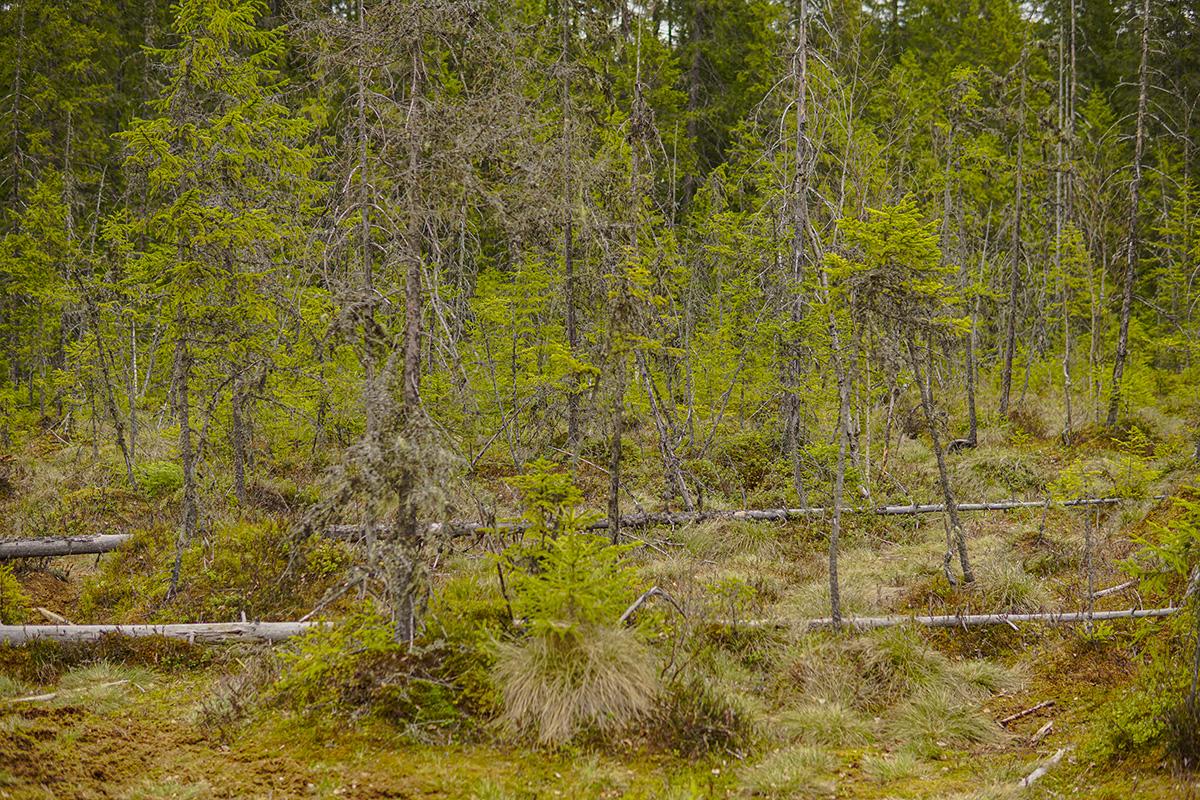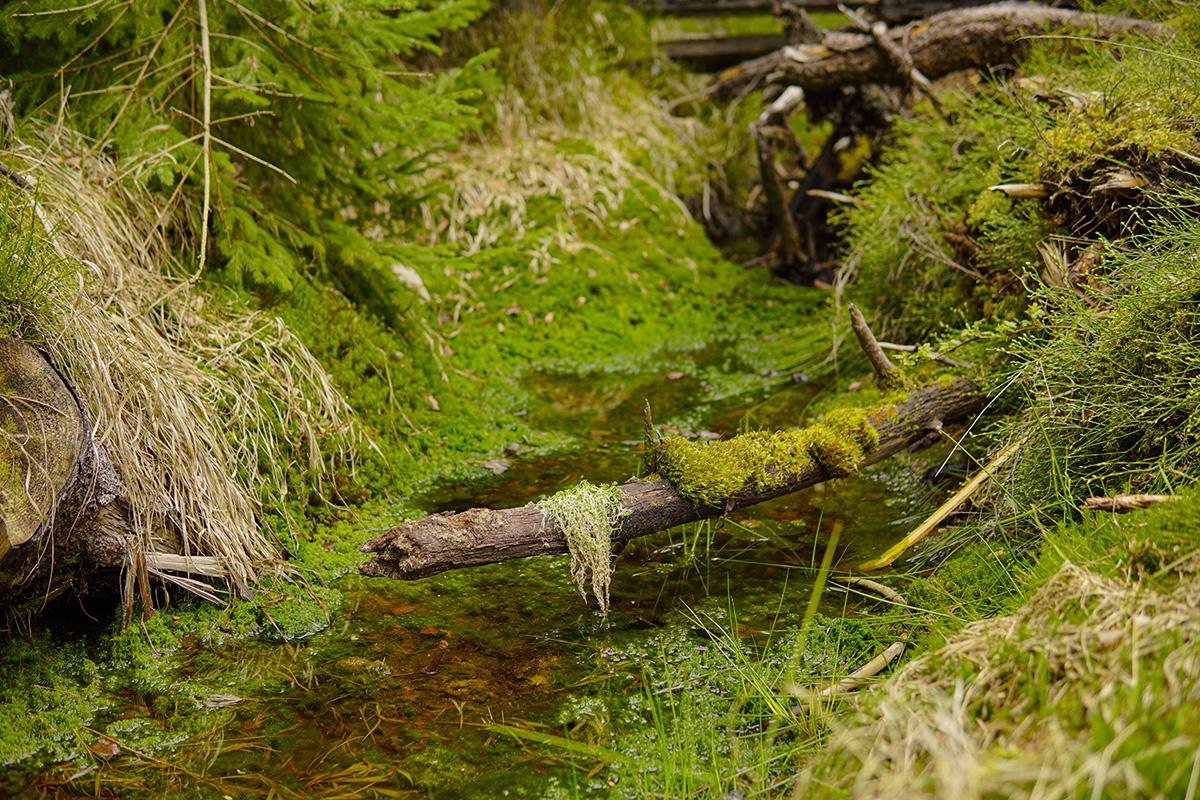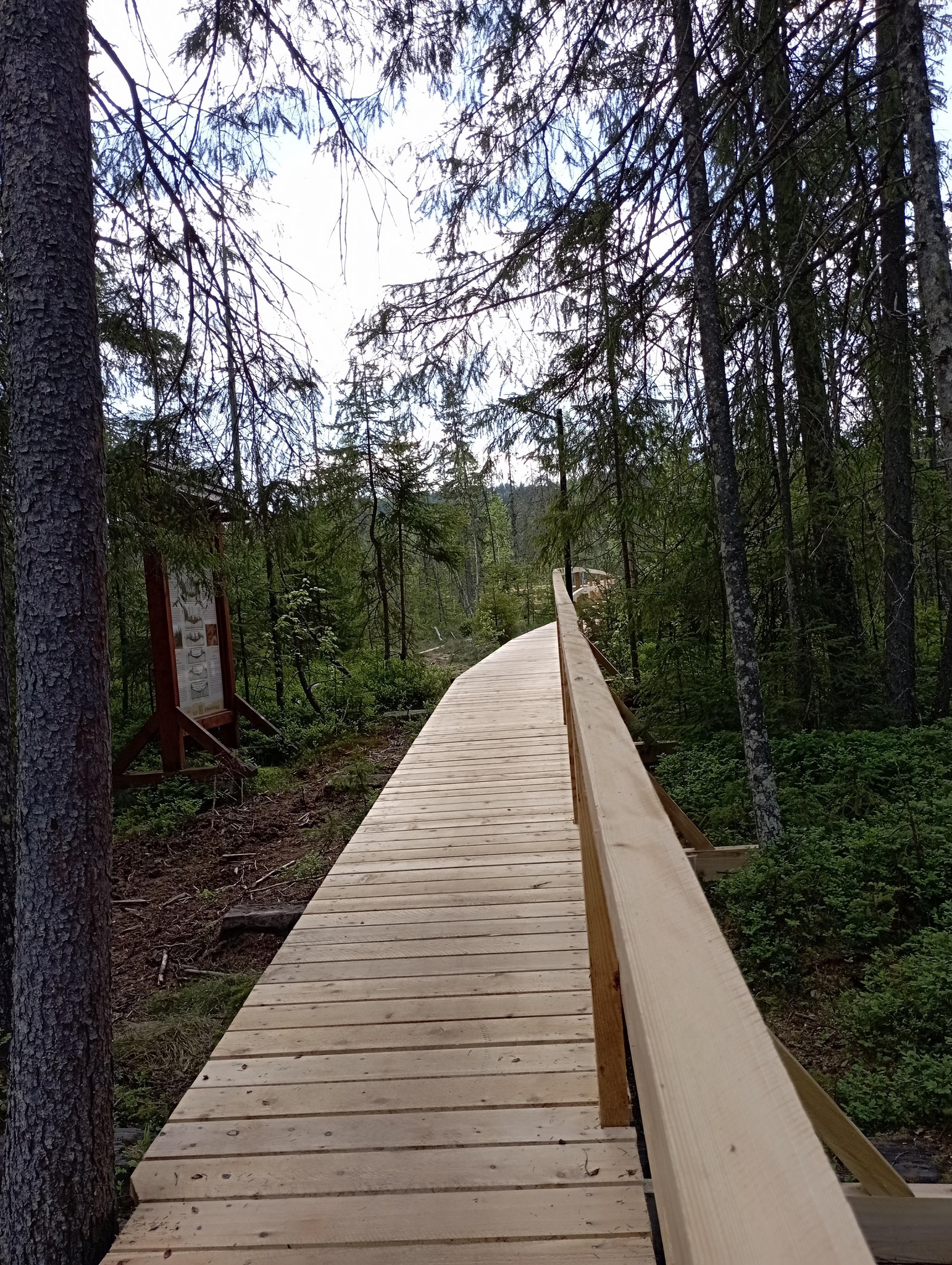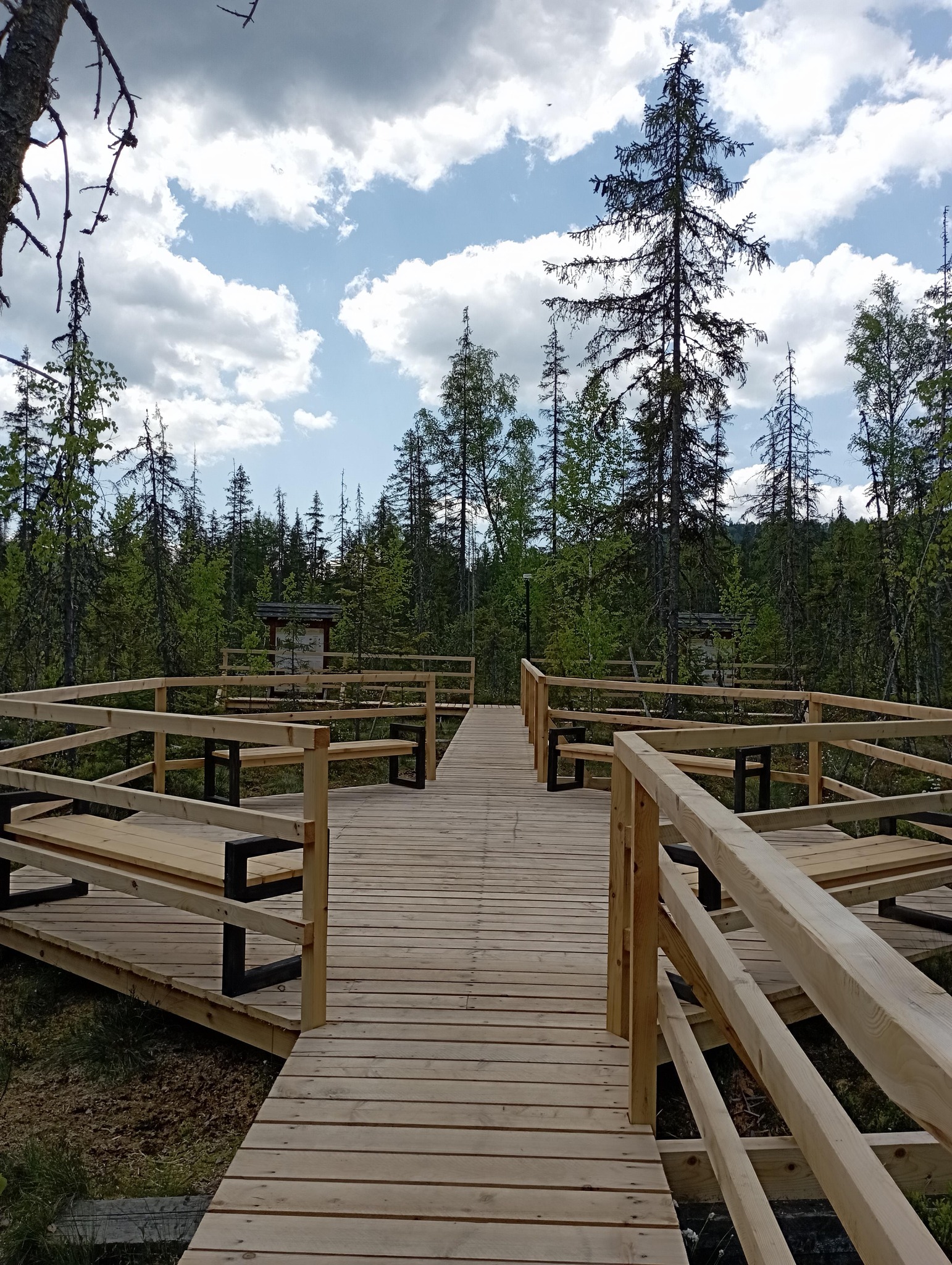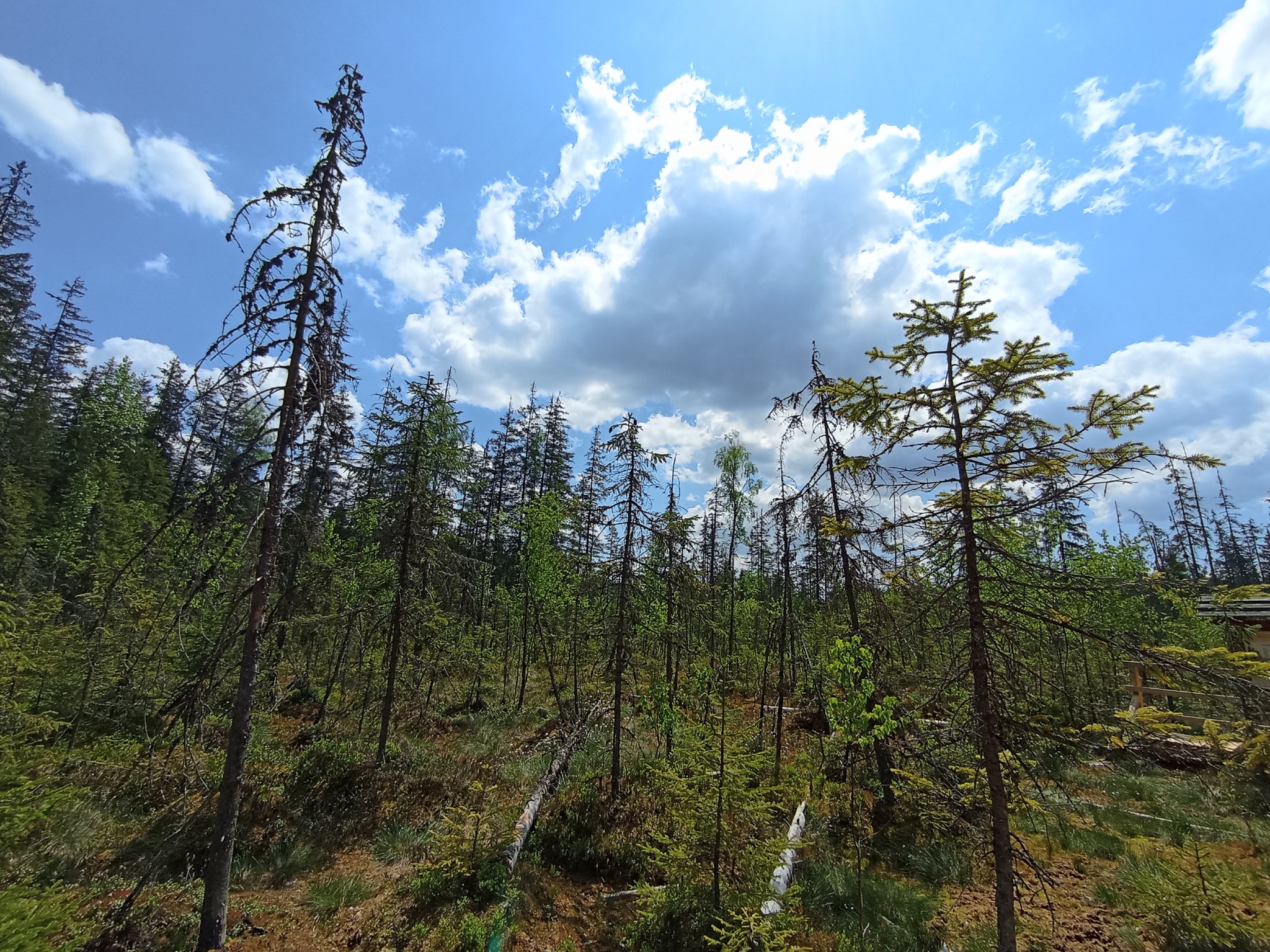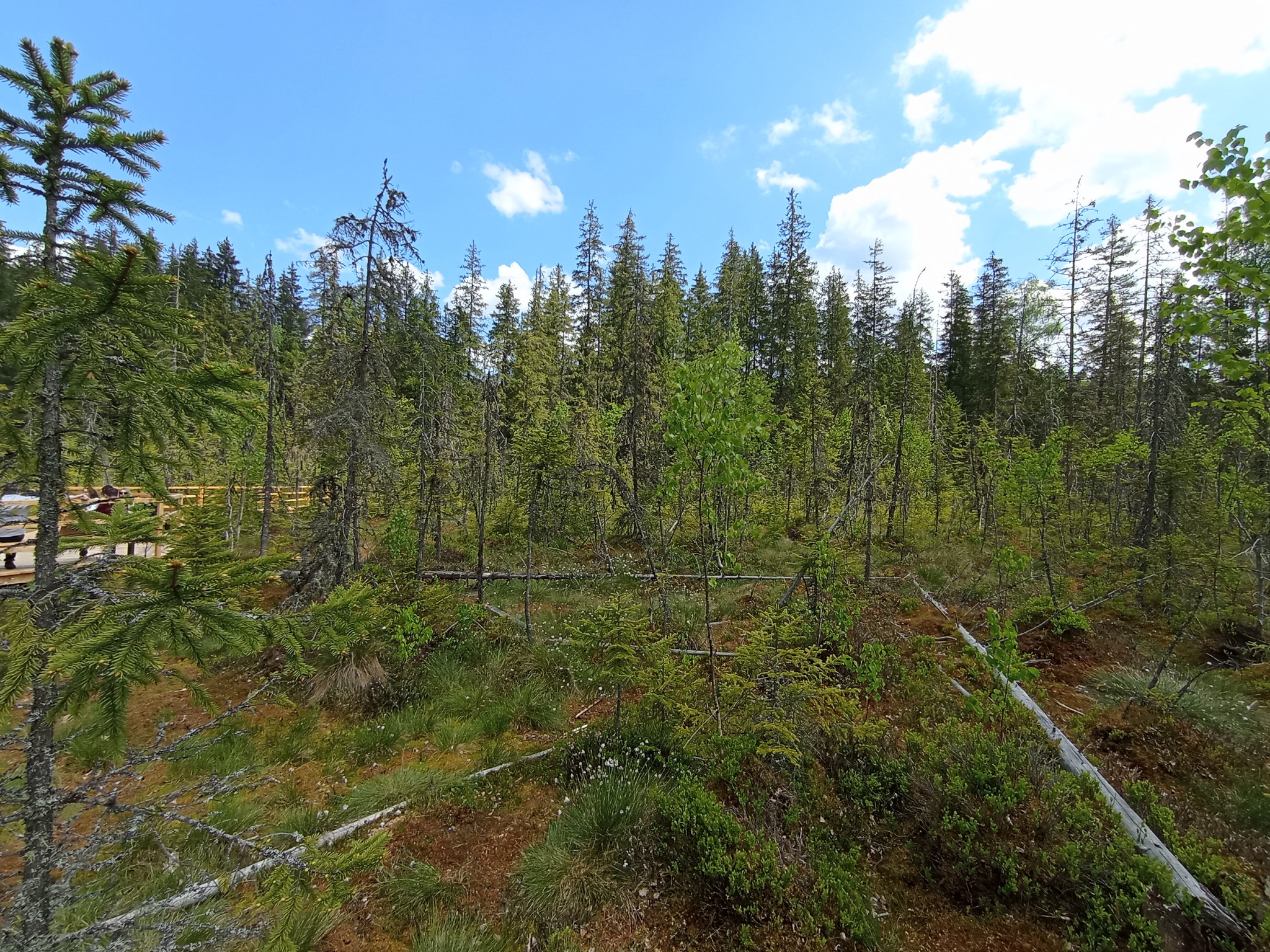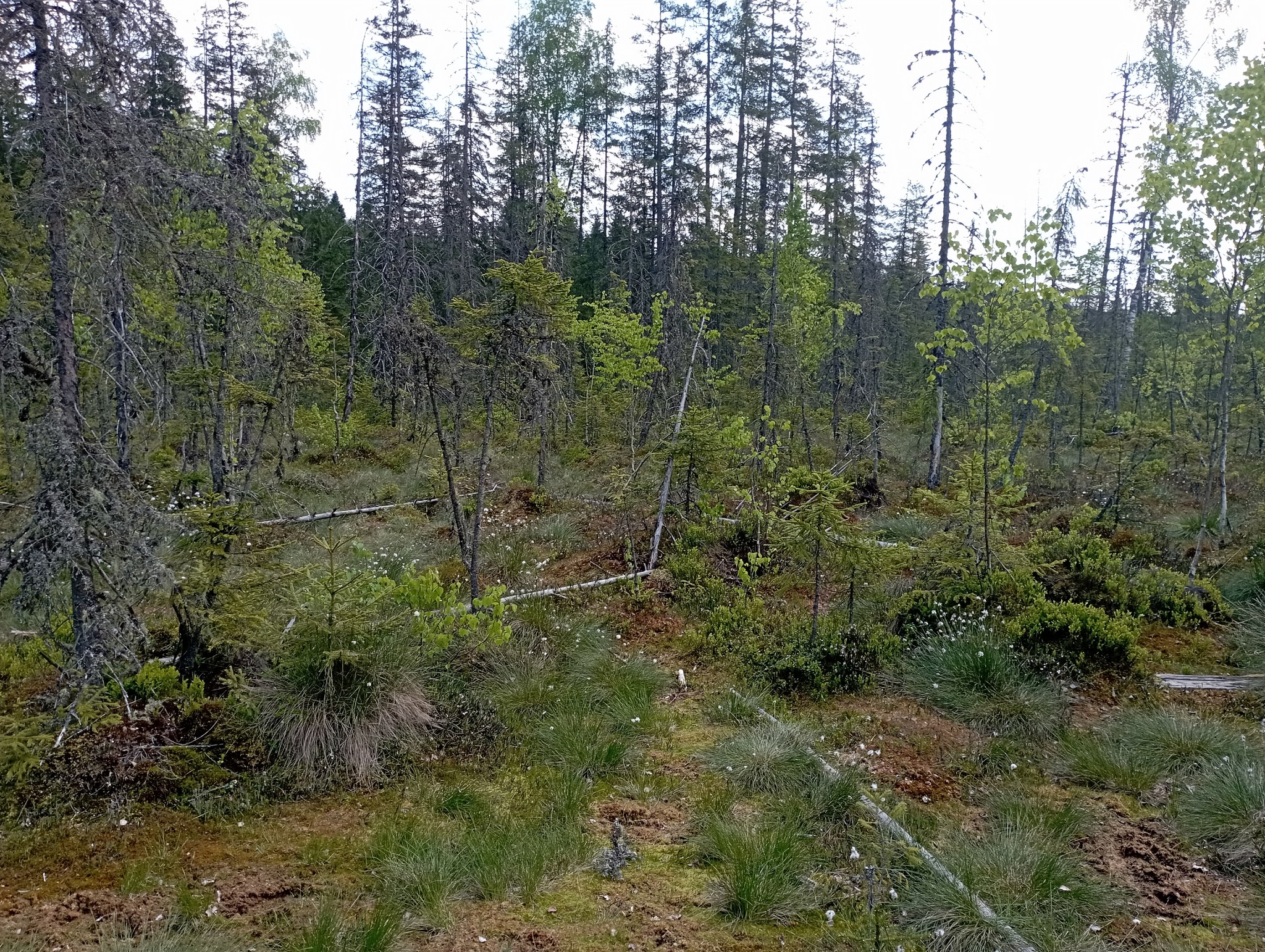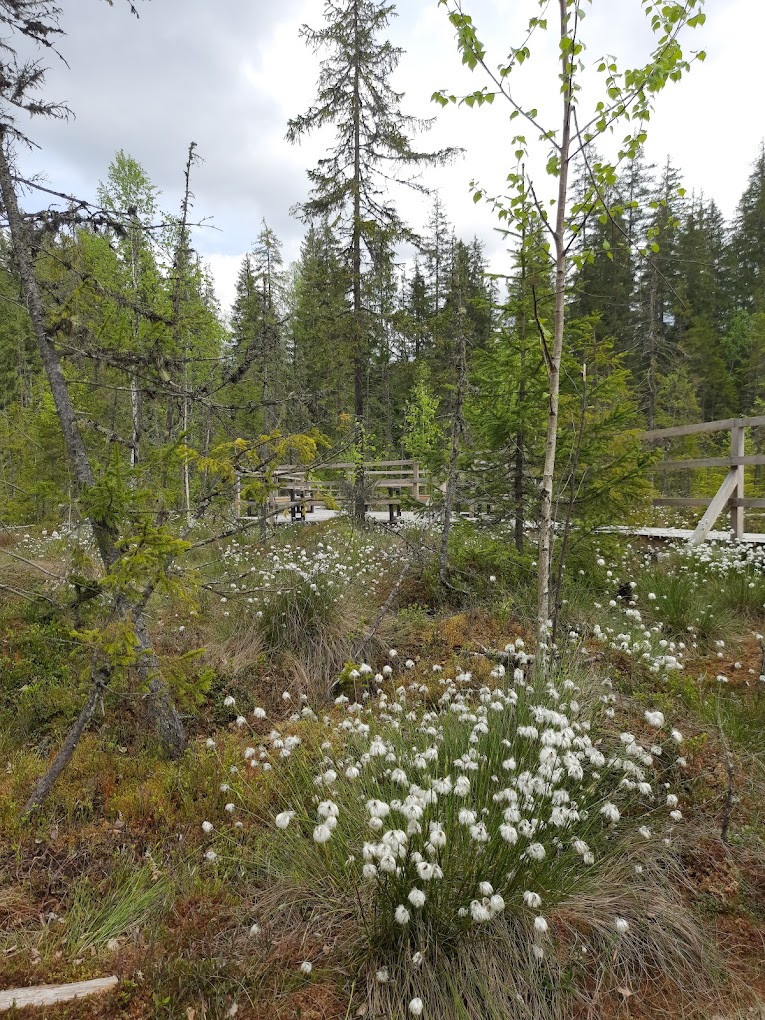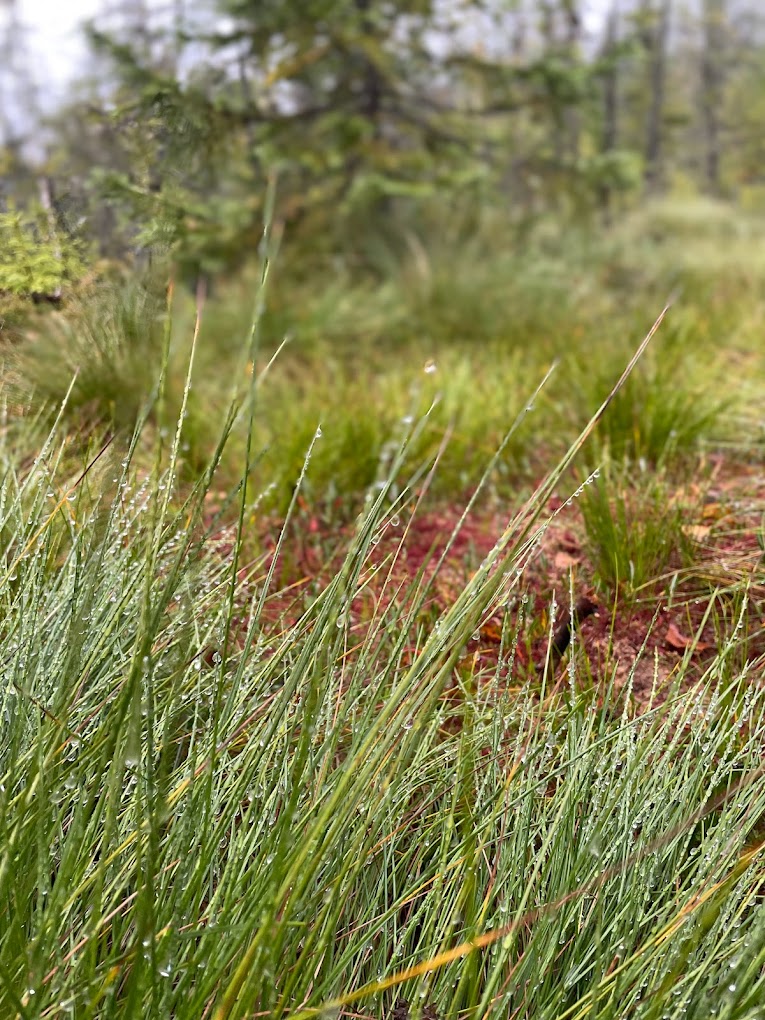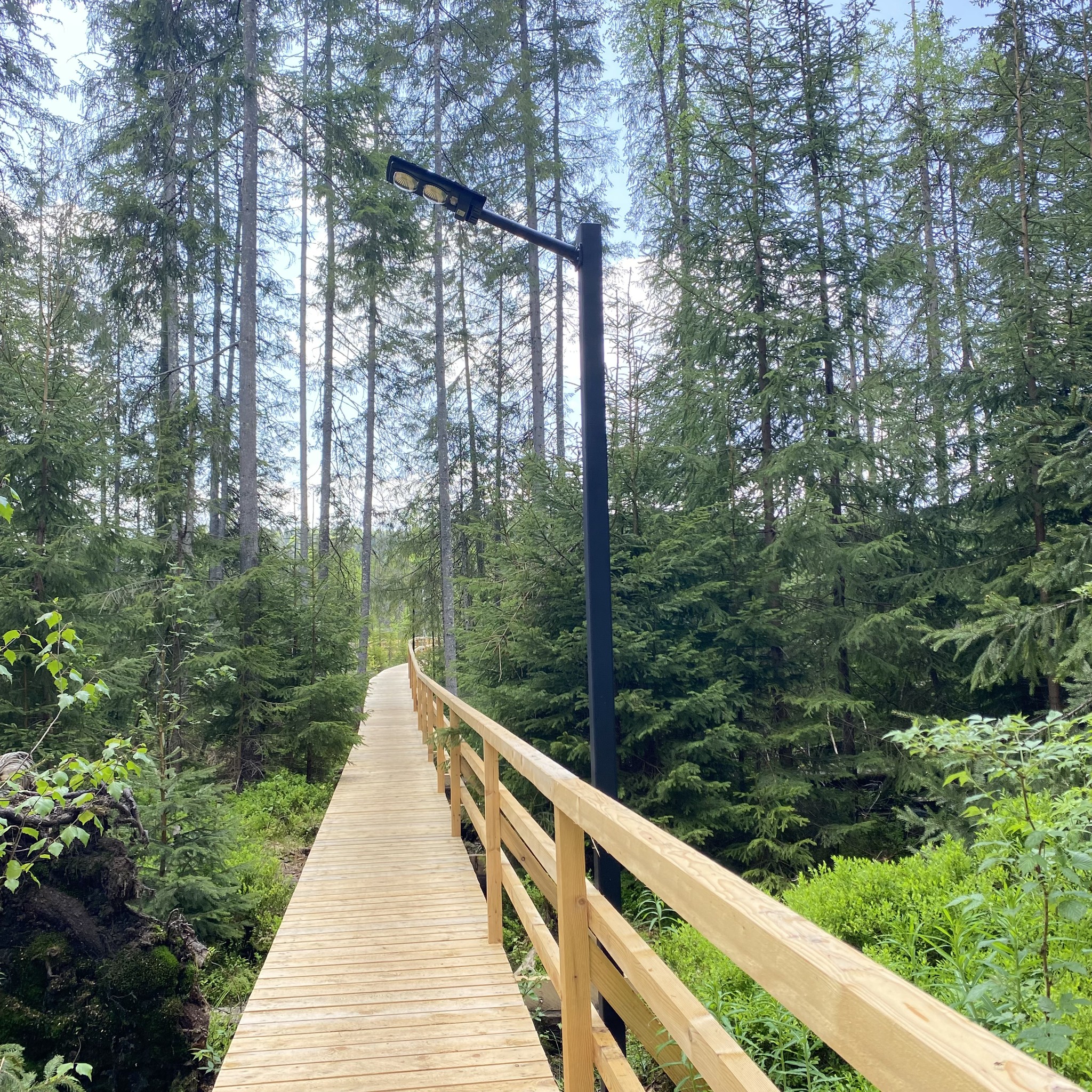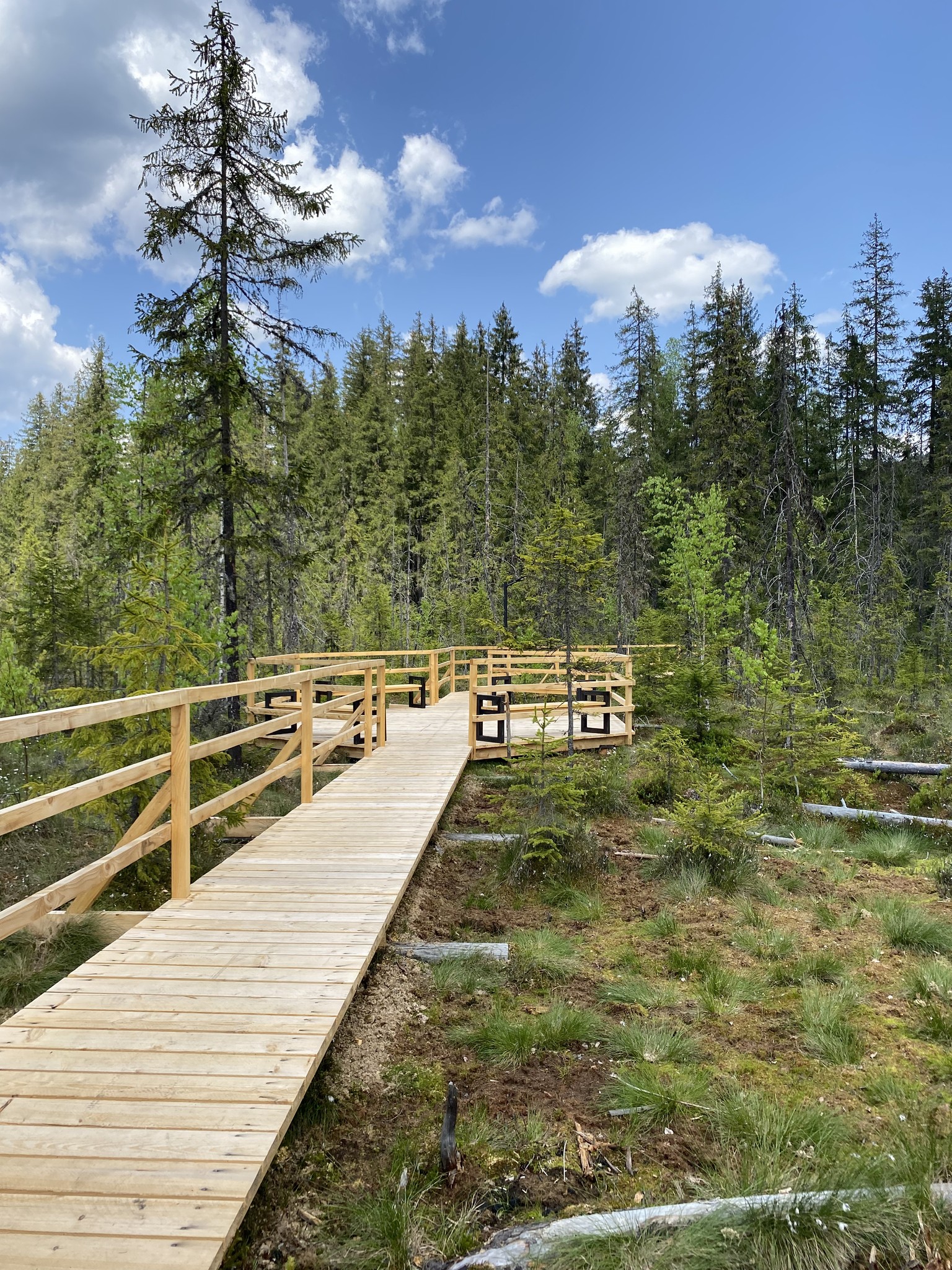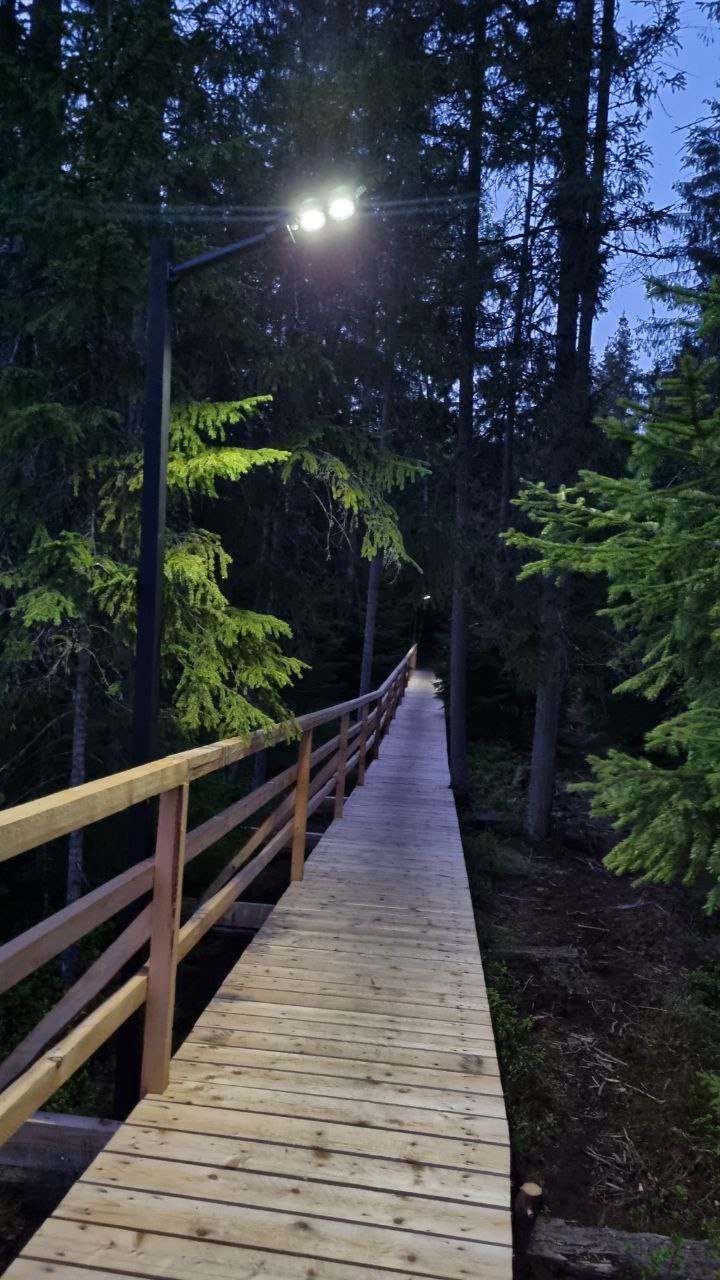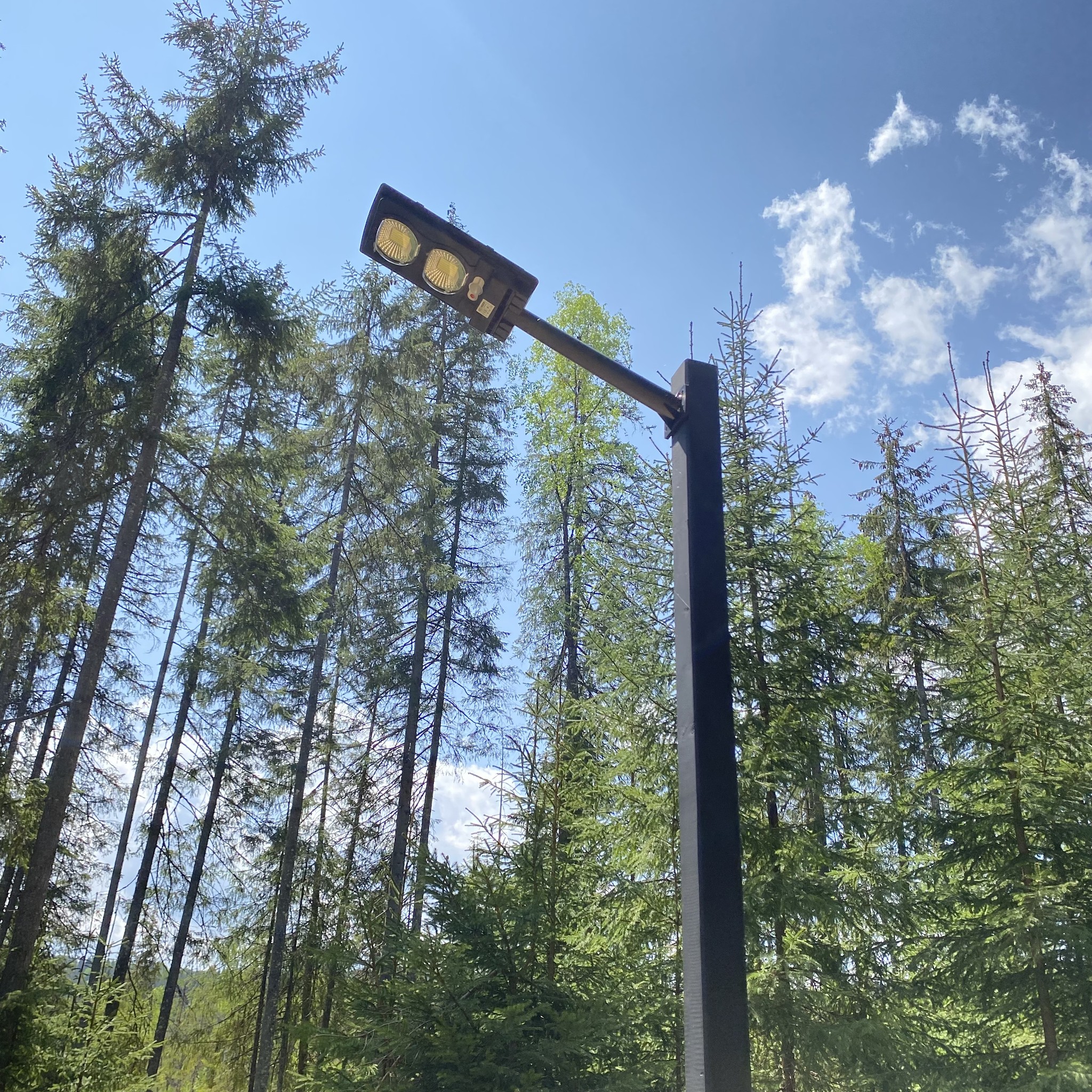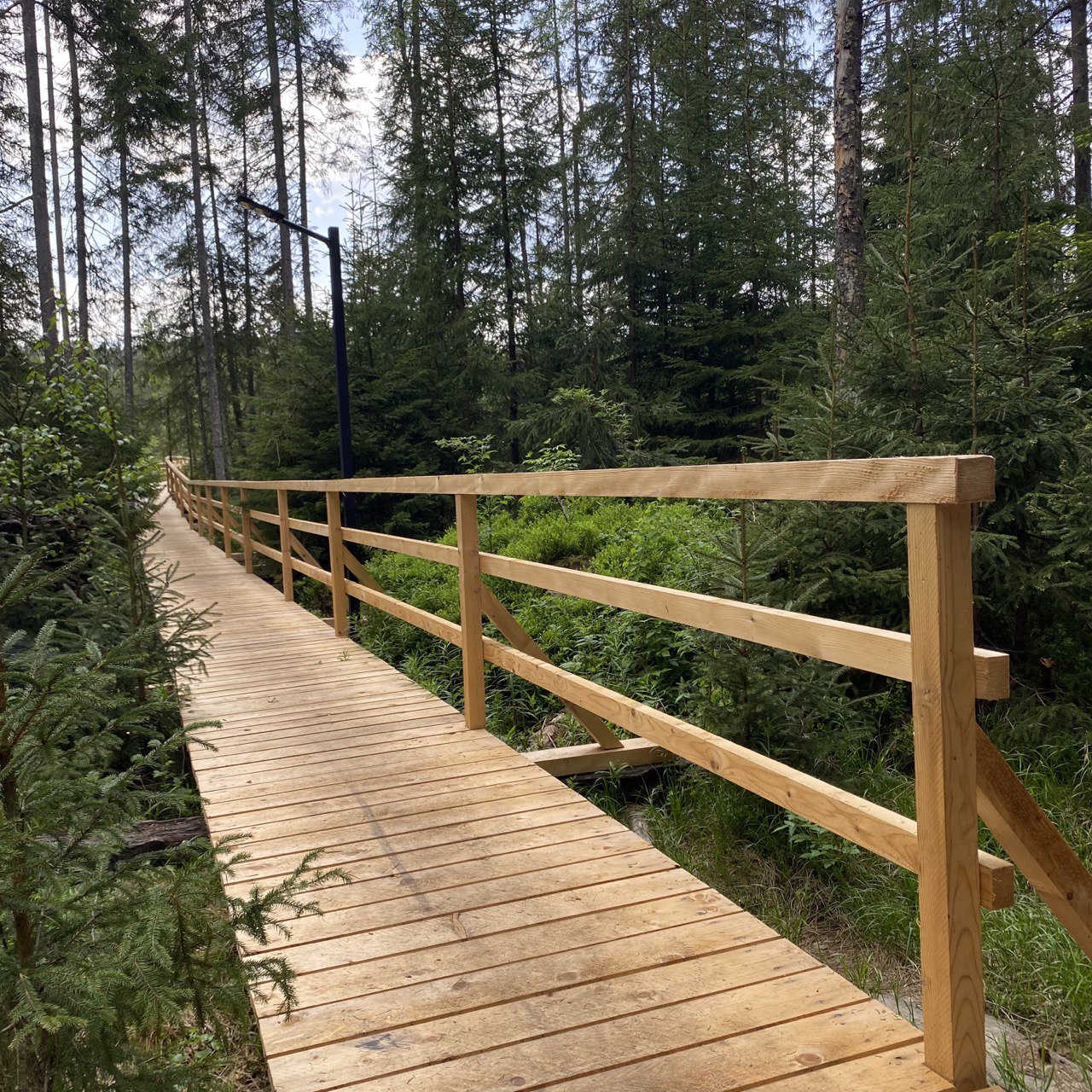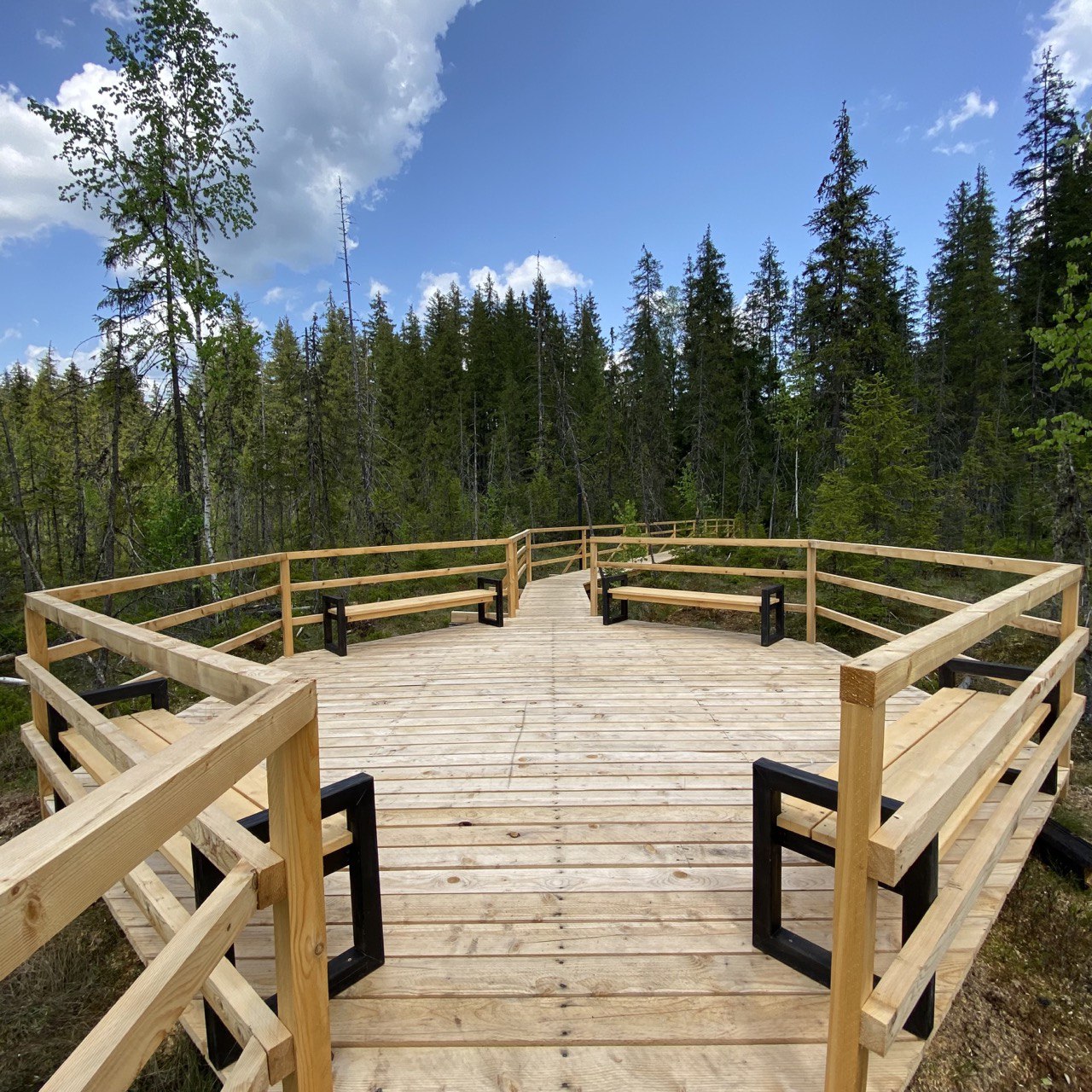Reconnecting with nature
Through nature - to community developmen
Promoting eco-tourism in the Vorokhtya community by improving the infrastructure of Rudyak marsh
The project to enhance the tourist appeal of the Vorokhtyanska community connects people with nature, raises environmental awareness, and improves visitor comfort. It includes wooden bridges, benches, interactive stands, an insect hotel, and a soil section installation at the Rudyak swamp, with signage for easy navigation. The project restores ecosystems, conserves biodiversity, and integrates nature-based solutions, ensuring accessibility and fostering community-nature harmony.
Ukraine
Local
Vorokhta, Ivano-Frankivsk region, Ukraine
Carpathian National Nature Park
Carpathian National Nature Park
Mainly rural
It refers to a physical transformation of the built environment (hard investment)
Yes
2023-06-15
Yes
WWF-Ukraine
No
No
As a representative of an organisation
The project is aimed at promoting ecotourism in the Vorokhtya community by improving the infrastructure of the Rudyak bog. It combines the preservation of the natural environment, raising the environmental awareness of visitors, and developing the tourist attractiveness of the region.
Target group:
The main beneficiaries of the project are tourists, local residents, environmental organizations, and the community of Vorokhta, which has received improved infrastructure and the opportunity for sustainable development of the region.
Specific objectives:
Restore the damaged infrastructure of the swamp (wooden paths, solar-powered lighting).
Installation of information stands and directional signs.
Promoting eco-tourism and raising awareness of natural resource conservation.
Creating an inclusive and accessible space for all.
Results achieved:
Improved infrastructure has made the location safer and more convenient for tourists.
Installed educational elements contribute to raising environmental awareness.
The use of nature-based solutions contributes to the conservation of biodiversity and sustainable development of the territory.
Harmonious interaction between the community and nature through environmental education and responsible use of natural resources has been created.
Integration of the principles of the New European Bauhaus:
The project combines aesthetics, sustainability, and inclusiveness:
The use of environmentally friendly materials and renewable energy sources.
The design of the infrastructure harmonizes with the natural landscape.
Inclusive access for all groups of people, including people with disabilities.
Solving specific problems of the territory:
The project improves the tourist image of the community, ensuring environmental and sustainable development.
It helps to preserve the unique natural ecosystem of the swamp.
Contributes to the economic development of the region by attracting more tourists and supporting local businesses.
Target group:
The main beneficiaries of the project are tourists, local residents, environmental organizations, and the community of Vorokhta, which has received improved infrastructure and the opportunity for sustainable development of the region.
Specific objectives:
Restore the damaged infrastructure of the swamp (wooden paths, solar-powered lighting).
Installation of information stands and directional signs.
Promoting eco-tourism and raising awareness of natural resource conservation.
Creating an inclusive and accessible space for all.
Results achieved:
Improved infrastructure has made the location safer and more convenient for tourists.
Installed educational elements contribute to raising environmental awareness.
The use of nature-based solutions contributes to the conservation of biodiversity and sustainable development of the territory.
Harmonious interaction between the community and nature through environmental education and responsible use of natural resources has been created.
Integration of the principles of the New European Bauhaus:
The project combines aesthetics, sustainability, and inclusiveness:
The use of environmentally friendly materials and renewable energy sources.
The design of the infrastructure harmonizes with the natural landscape.
Inclusive access for all groups of people, including people with disabilities.
Solving specific problems of the territory:
The project improves the tourist image of the community, ensuring environmental and sustainable development.
It helps to preserve the unique natural ecosystem of the swamp.
Contributes to the economic development of the region by attracting more tourists and supporting local businesses.
Ecotourism
Sustainable development
Biodiversity conservation
Inclusive infrastructure
Environmental awareness
Exemplary Nature in the Context of the Three Core Values of the New European Bauhaus
The project exemplifies the core values of the New European Bauhaus—sustainability, aesthetics, and inclusiveness—by integrating ecological conservation, innovative design, and community accessibility.
Sustainability:
The project actively contributes to environmental protection by restoring the infrastructure of Rudyak bog using eco-friendly materials and solar-powered lighting.
The conservation of biodiversity is enhanced through information stands and educational campaigns promoting responsible ecotourism.
The initiative reduces human impact on fragile ecosystems by providing designated walking paths and structured visitor access.
Aesthetics:
The project maintains harmony with the natural landscape by utilizing materials that blend seamlessly into the environment.
Informational installations are designed to be visually appealing while providing educational content about the local ecosystem.
The layout of the space fosters an immersive experience, allowing visitors to appreciate the natural beauty of the bog while engaging with its ecological importance.
Inclusiveness:
The site is made accessible to a diverse range of visitors, including individuals with disabilities, through the construction of well-designed wooden pathways and inclusive infrastructure.
The project fosters community involvement by engaging local residents and organizations in the promotion and maintenance of the ecotourism space.
Public awareness campaigns and educational initiatives ensure that people of all backgrounds can engage with and benefit from the conservation efforts.
By combining these elements, the project serves as a model for sustainable ecotourism development, balancing ecological responsibility, aesthetic value, and social inclusivity.
The project exemplifies the core values of the New European Bauhaus—sustainability, aesthetics, and inclusiveness—by integrating ecological conservation, innovative design, and community accessibility.
Sustainability:
The project actively contributes to environmental protection by restoring the infrastructure of Rudyak bog using eco-friendly materials and solar-powered lighting.
The conservation of biodiversity is enhanced through information stands and educational campaigns promoting responsible ecotourism.
The initiative reduces human impact on fragile ecosystems by providing designated walking paths and structured visitor access.
Aesthetics:
The project maintains harmony with the natural landscape by utilizing materials that blend seamlessly into the environment.
Informational installations are designed to be visually appealing while providing educational content about the local ecosystem.
The layout of the space fosters an immersive experience, allowing visitors to appreciate the natural beauty of the bog while engaging with its ecological importance.
Inclusiveness:
The site is made accessible to a diverse range of visitors, including individuals with disabilities, through the construction of well-designed wooden pathways and inclusive infrastructure.
The project fosters community involvement by engaging local residents and organizations in the promotion and maintenance of the ecotourism space.
Public awareness campaigns and educational initiatives ensure that people of all backgrounds can engage with and benefit from the conservation efforts.
By combining these elements, the project serves as a model for sustainable ecotourism development, balancing ecological responsibility, aesthetic value, and social inclusivity.
Key Objectives of the Project in Terms of Aesthetics and Quality of Experience
The project prioritizes aesthetics and the enhancement of visitor experiences by integrating thoughtful design and cultural appreciation into the development of the Rudyak bog ecotourism site.
Aesthetic and Experiential Design:
Harmonious Integration: The infrastructure was designed to blend seamlessly with the natural landscape, using locally sourced, sustainable materials that complement the surrounding environment.
Immersive Experience: Wooden pathways, strategically placed seating areas, and viewing platforms allow visitors to experience the bog’s beauty while minimizing ecological disturbance.
Engaging Educational Elements: Interactive stands and artistic installations provide informative yet visually appealing ways for visitors to learn about the ecosystem and its significance.
Cultural and Design Advantages:
Connection to Local Heritage: The design incorporates elements inspired by traditional Carpathian architecture, reinforcing the cultural identity of the region.
Interpretive Storytelling: Information panels narrate the history and ecological importance of the bog, fostering a deeper appreciation for its conservation.
Inclusive and Accessible Design: The space is created to be welcoming to all visitors, including those with disabilities, ensuring equal access to cultural and environmental learning.
Exemplary Nature of the Project:
This project serves as a model by demonstrating how sustainable tourism can be both visually appealing and enriching. It successfully integrates nature, design, and education, offering a holistic experience that fosters a stronger emotional connection between people and the natural world. The balance between aesthetics, environmental preservation, and cultural storytelling makes it a leading example of ecotourism development.
The project prioritizes aesthetics and the enhancement of visitor experiences by integrating thoughtful design and cultural appreciation into the development of the Rudyak bog ecotourism site.
Aesthetic and Experiential Design:
Harmonious Integration: The infrastructure was designed to blend seamlessly with the natural landscape, using locally sourced, sustainable materials that complement the surrounding environment.
Immersive Experience: Wooden pathways, strategically placed seating areas, and viewing platforms allow visitors to experience the bog’s beauty while minimizing ecological disturbance.
Engaging Educational Elements: Interactive stands and artistic installations provide informative yet visually appealing ways for visitors to learn about the ecosystem and its significance.
Cultural and Design Advantages:
Connection to Local Heritage: The design incorporates elements inspired by traditional Carpathian architecture, reinforcing the cultural identity of the region.
Interpretive Storytelling: Information panels narrate the history and ecological importance of the bog, fostering a deeper appreciation for its conservation.
Inclusive and Accessible Design: The space is created to be welcoming to all visitors, including those with disabilities, ensuring equal access to cultural and environmental learning.
Exemplary Nature of the Project:
This project serves as a model by demonstrating how sustainable tourism can be both visually appealing and enriching. It successfully integrates nature, design, and education, offering a holistic experience that fosters a stronger emotional connection between people and the natural world. The balance between aesthetics, environmental preservation, and cultural storytelling makes it a leading example of ecotourism development.
Key Objectives of the Project in Terms of Inclusion
The project prioritizes inclusivity by ensuring that the Rudyak bog ecotourism site is accessible, affordable, and governed with community engagement. Through a combination of design principles, social initiatives, and economic strategies, the project creates a welcoming space for all visitors.
Accessibility and Affordability:
Universal Design: The infrastructure follows “design for all” principles, including wide wooden pathways suitable for wheelchairs and strollers, seating areas at regular intervals, and clear signage with Braille options.
Low-Cost Access: The site remains free to visit, ensuring affordability and eliminating financial barriers for low-income visitors.
Multi-Language and Sensory Accessibility: Informational materials and guided tours are available in multiple languages, including visual and audio formats to support individuals with different needs.
Inclusive Governance and Community Engagement:
Community-Led Decision Making: Local residents, businesses, and conservation experts were actively involved in planning and implementing the project.
Employment and Volunteering Opportunities: The initiative prioritizes hiring local workforce and engaging volunteers to maintain the site, fostering economic inclusion.
Educational and Cultural Representation: The project highlights regional traditions and ecological knowledge, ensuring that the local community’s identity is preserved and celebrated.
Exemplary Nature of the Project:
This initiative sets a high standard for inclusive tourism by demonstrating how accessible design, community participation, and affordability can be harmoniously integrated into ecotourism. By removing physical, financial, and informational barriers, it serves as a model for equitable access to nature, cultural education, and sustainable development.
The project prioritizes inclusivity by ensuring that the Rudyak bog ecotourism site is accessible, affordable, and governed with community engagement. Through a combination of design principles, social initiatives, and economic strategies, the project creates a welcoming space for all visitors.
Accessibility and Affordability:
Universal Design: The infrastructure follows “design for all” principles, including wide wooden pathways suitable for wheelchairs and strollers, seating areas at regular intervals, and clear signage with Braille options.
Low-Cost Access: The site remains free to visit, ensuring affordability and eliminating financial barriers for low-income visitors.
Multi-Language and Sensory Accessibility: Informational materials and guided tours are available in multiple languages, including visual and audio formats to support individuals with different needs.
Inclusive Governance and Community Engagement:
Community-Led Decision Making: Local residents, businesses, and conservation experts were actively involved in planning and implementing the project.
Employment and Volunteering Opportunities: The initiative prioritizes hiring local workforce and engaging volunteers to maintain the site, fostering economic inclusion.
Educational and Cultural Representation: The project highlights regional traditions and ecological knowledge, ensuring that the local community’s identity is preserved and celebrated.
Exemplary Nature of the Project:
This initiative sets a high standard for inclusive tourism by demonstrating how accessible design, community participation, and affordability can be harmoniously integrated into ecotourism. By removing physical, financial, and informational barriers, it serves as a model for equitable access to nature, cultural education, and sustainable development.
Exemplary Nature in the Context of the Three Principles of the New European Bauhaus
The project integrates sustainability, aesthetics, and inclusion through active citizen engagement, ecological responsibility, and community-centered design.
Citizen and Civil Society Engagement:
Participatory Planning: Local residents, conservationists, and stakeholders contributed to the project’s design and implementation.
Public Consultations & Workshops: Meetings and workshops ensured the project met community needs and promoted ecological awareness.
Local Workforce & Volunteers: Residents played a role in infrastructure development, maintenance, and environmental education.
Impact of Engagement:
Community Ownership: Involvement strengthened local stewardship over the Rudyak bog.
Better Accessibility & Design: Feedback shaped infrastructure to be inclusive and environmentally sustainable.
Increased Awareness: Engagement promoted responsible tourism and biodiversity conservation.
Role & Contribution:
Residents: Provided insights on accessibility and cultural value.
Environmental Organizations: Offered expertise on conservation.
Visitors: Shared feedback to enhance the experience.
Exemplary Model:
The project demonstrates how public participation ensures sustainable tourism by balancing ecological care, aesthetics, and inclusivity.
The project integrates sustainability, aesthetics, and inclusion through active citizen engagement, ecological responsibility, and community-centered design.
Citizen and Civil Society Engagement:
Participatory Planning: Local residents, conservationists, and stakeholders contributed to the project’s design and implementation.
Public Consultations & Workshops: Meetings and workshops ensured the project met community needs and promoted ecological awareness.
Local Workforce & Volunteers: Residents played a role in infrastructure development, maintenance, and environmental education.
Impact of Engagement:
Community Ownership: Involvement strengthened local stewardship over the Rudyak bog.
Better Accessibility & Design: Feedback shaped infrastructure to be inclusive and environmentally sustainable.
Increased Awareness: Engagement promoted responsible tourism and biodiversity conservation.
Role & Contribution:
Residents: Provided insights on accessibility and cultural value.
Environmental Organizations: Offered expertise on conservation.
Visitors: Shared feedback to enhance the experience.
Exemplary Model:
The project demonstrates how public participation ensures sustainable tourism by balancing ecological care, aesthetics, and inclusivity.
Stakeholder Involvement at Different Levels
The project engaged stakeholders at local, regional, national, and European levels, ensuring a comprehensive and collaborative approach to sustainable ecotourism development.
Local Level:
Municipal Authorities: Provided administrative support, infrastructure maintenance, and policy alignment.
Residents & Businesses: Contributed insights on accessibility and local needs, fostering community ownership.
Local NGOs & Volunteers: Assisted with environmental education, biodiversity conservation, and visitor engagement.
Regional Level:
Tourism & Environmental Agencies: Supported with research, funding opportunities, and promotional efforts.
Protected Area Authorities: Ensured ecological balance, compliance with conservation policies, and habitat protection.
National Level:
Government Ministries & Agencies: Offered regulatory guidance and integrated the project into national ecotourism and sustainability strategies.
Academic Institutions: Conducted impact assessments, ecological studies, and provided expert recommendations.
European Level:
EU Funding & Cooperation Programs: Provided financial resources and best practices from similar projects across Europe.
International Conservation Networks: Shared expertise, connected stakeholders, and amplified the project’s impact on a broader scale.
Added Value of Stakeholder Participation:
Enhanced Sustainability: Multi-level support ensured the project aligns with ecological preservation and policy frameworks.
Increased Visibility: European and national collaboration elevated the project’s profile, attracting more visitors and investments.
Knowledge Exchange: Contributions from various sectors enriched project implementation, making it a replicable model for ecotourism and conservation.
By integrating diverse stakeholders, the project achieved a balanced, inclusive, and well-supported approach, ensuring its long-term success and broader impact.
The project engaged stakeholders at local, regional, national, and European levels, ensuring a comprehensive and collaborative approach to sustainable ecotourism development.
Local Level:
Municipal Authorities: Provided administrative support, infrastructure maintenance, and policy alignment.
Residents & Businesses: Contributed insights on accessibility and local needs, fostering community ownership.
Local NGOs & Volunteers: Assisted with environmental education, biodiversity conservation, and visitor engagement.
Regional Level:
Tourism & Environmental Agencies: Supported with research, funding opportunities, and promotional efforts.
Protected Area Authorities: Ensured ecological balance, compliance with conservation policies, and habitat protection.
National Level:
Government Ministries & Agencies: Offered regulatory guidance and integrated the project into national ecotourism and sustainability strategies.
Academic Institutions: Conducted impact assessments, ecological studies, and provided expert recommendations.
European Level:
EU Funding & Cooperation Programs: Provided financial resources and best practices from similar projects across Europe.
International Conservation Networks: Shared expertise, connected stakeholders, and amplified the project’s impact on a broader scale.
Added Value of Stakeholder Participation:
Enhanced Sustainability: Multi-level support ensured the project aligns with ecological preservation and policy frameworks.
Increased Visibility: European and national collaboration elevated the project’s profile, attracting more visitors and investments.
Knowledge Exchange: Contributions from various sectors enriched project implementation, making it a replicable model for ecotourism and conservation.
By integrating diverse stakeholders, the project achieved a balanced, inclusive, and well-supported approach, ensuring its long-term success and broader impact.
Interdisciplinary Collaboration in Project Development
The project integrated environmental science, architecture, tourism, education, and governance to ensure sustainable ecotourism development.
Key Fields and Roles:
Environmental Science: Experts from the Carpathian National Nature Park guided ecosystem preservation and infrastructure placement.
Architecture & Design: Developed eco-friendly pathways and signage blending with the natural landscape.
Tourism Management: Created strategies for sustainable visitor engagement and economic benefits.
Education & Public Awareness: Produced informational materials on biodiversity and conservation.
Local Governance: Ensured regulatory compliance and policy support.
Collaboration with the Carpathian National Nature Park:
Provided ecological expertise to minimize environmental impact.
Developed educational content to promote conservation awareness.
Supported joint promotional campaigns to increase site recognition.
Added Value:
Sustainable Development: Balanced ecological, architectural, and tourism priorities.
Environmental Protection: Ensured infrastructure supports biodiversity.
Enhanced Visitor Experience: Combined science, design, and education for immersive engagement.
This interdisciplinary approach created a replicable model for ecotourism in protected areas.
The project integrated environmental science, architecture, tourism, education, and governance to ensure sustainable ecotourism development.
Key Fields and Roles:
Environmental Science: Experts from the Carpathian National Nature Park guided ecosystem preservation and infrastructure placement.
Architecture & Design: Developed eco-friendly pathways and signage blending with the natural landscape.
Tourism Management: Created strategies for sustainable visitor engagement and economic benefits.
Education & Public Awareness: Produced informational materials on biodiversity and conservation.
Local Governance: Ensured regulatory compliance and policy support.
Collaboration with the Carpathian National Nature Park:
Provided ecological expertise to minimize environmental impact.
Developed educational content to promote conservation awareness.
Supported joint promotional campaigns to increase site recognition.
Added Value:
Sustainable Development: Balanced ecological, architectural, and tourism priorities.
Environmental Protection: Ensured infrastructure supports biodiversity.
Enhanced Visitor Experience: Combined science, design, and education for immersive engagement.
This interdisciplinary approach created a replicable model for ecotourism in protected areas.
Innovative Dimension Compared to Standard Practices
The project introduces a novel approach to ecotourism and conservation by integrating advanced sustainability, inclusivity, and education strategies, setting it apart from conventional practices in the field.
Key Innovations:
Sustainable Infrastructure: Unlike typical ecotourism projects, this initiative employs eco-friendly materials, solar-powered lighting, and minimal-impact pathways to preserve the delicate ecosystem.
Interactive Education: Instead of static informational signs, the project incorporates interactive installations, engaging visitors in biodiversity conservation and climate awareness.
Inclusive Design: While many nature trails lack accessibility, this project ensures universal access through wheelchair-friendly pathways, Braille signage, and multilingual guides.
Community Co-Creation: Rather than relying solely on top-down management, the project involves local stakeholders, conservationists, and residents in decision-making, fostering a sense of ownership and sustainability.
Integration with Protected Areas: Unlike standard tourism developments that often disrupt ecosystems, this project collaborates closely with the Carpathian National Nature Park to align with conservation goals while enhancing visitor experience.
Impact & Added Value:
Enhanced Sustainability: Reduces human impact while increasing ecological awareness.
Stronger Community Involvement: Empowers locals to participate in long-term environmental stewardship.
Scalable Model: Provides a replicable framework for ecotourism in other protected areas.
By combining sustainability, accessibility, and educational engagement, the project sets a new benchmark in ecotourism and conservation practices.
The project introduces a novel approach to ecotourism and conservation by integrating advanced sustainability, inclusivity, and education strategies, setting it apart from conventional practices in the field.
Key Innovations:
Sustainable Infrastructure: Unlike typical ecotourism projects, this initiative employs eco-friendly materials, solar-powered lighting, and minimal-impact pathways to preserve the delicate ecosystem.
Interactive Education: Instead of static informational signs, the project incorporates interactive installations, engaging visitors in biodiversity conservation and climate awareness.
Inclusive Design: While many nature trails lack accessibility, this project ensures universal access through wheelchair-friendly pathways, Braille signage, and multilingual guides.
Community Co-Creation: Rather than relying solely on top-down management, the project involves local stakeholders, conservationists, and residents in decision-making, fostering a sense of ownership and sustainability.
Integration with Protected Areas: Unlike standard tourism developments that often disrupt ecosystems, this project collaborates closely with the Carpathian National Nature Park to align with conservation goals while enhancing visitor experience.
Impact & Added Value:
Enhanced Sustainability: Reduces human impact while increasing ecological awareness.
Stronger Community Involvement: Empowers locals to participate in long-term environmental stewardship.
Scalable Model: Provides a replicable framework for ecotourism in other protected areas.
By combining sustainability, accessibility, and educational engagement, the project sets a new benchmark in ecotourism and conservation practices.
Methodology and Approach Used in the Project
The project adopted a multidisciplinary, participatory, and sustainability-driven approach to ecotourism development, ensuring environmental protection, community involvement, and visitor accessibility.
Key Methodological Approaches:
Participatory Planning: Engaged local residents, conservationists, and stakeholders through consultations, ensuring alignment with community needs and ecological priorities.
Sustainable Infrastructure Development: Applied nature-based solutions, including eco-friendly materials and solar-powered installations, minimizing the environmental footprint.
Educational Integration: Designed interactive learning experiences through signage, digital content, and guided tours, fostering ecological awareness among visitors.
Inclusive Design Principles: Ensured accessibility for all, incorporating wheelchair-friendly paths, Braille signage, and multilingual information.
Collaborative Management: Partnered with the Carpathian National Nature Park to ensure biodiversity protection and sustainable tourism practices.
Monitoring & Evaluation: Implemented feedback loops, visitor impact assessments, and adaptive management strategies to refine and enhance the project over time.
Impact of the Methodology:
Balanced conservation with tourism by applying science-driven decision-making.
Strengthened local engagement and ownership, fostering long-term sustainability.
Provided a replicable model for ecotourism projects in protected natural areas.
By integrating ecological science, community collaboration, and sustainability principles, the project sets a new standard in responsible ecotourism development.
The project adopted a multidisciplinary, participatory, and sustainability-driven approach to ecotourism development, ensuring environmental protection, community involvement, and visitor accessibility.
Key Methodological Approaches:
Participatory Planning: Engaged local residents, conservationists, and stakeholders through consultations, ensuring alignment with community needs and ecological priorities.
Sustainable Infrastructure Development: Applied nature-based solutions, including eco-friendly materials and solar-powered installations, minimizing the environmental footprint.
Educational Integration: Designed interactive learning experiences through signage, digital content, and guided tours, fostering ecological awareness among visitors.
Inclusive Design Principles: Ensured accessibility for all, incorporating wheelchair-friendly paths, Braille signage, and multilingual information.
Collaborative Management: Partnered with the Carpathian National Nature Park to ensure biodiversity protection and sustainable tourism practices.
Monitoring & Evaluation: Implemented feedback loops, visitor impact assessments, and adaptive management strategies to refine and enhance the project over time.
Impact of the Methodology:
Balanced conservation with tourism by applying science-driven decision-making.
Strengthened local engagement and ownership, fostering long-term sustainability.
Provided a replicable model for ecotourism projects in protected natural areas.
By integrating ecological science, community collaboration, and sustainability principles, the project sets a new standard in responsible ecotourism development.
High Potential for Transferability and Replication
The project incorporates scalable and adaptable elements that can be replicated in different locations, benefiting various communities and environmental contexts. These elements include methodology, sustainable technologies, participatory processes, and educational components.
Transferable Elements:
Sustainable Infrastructure: The use of eco-friendly materials, solar-powered lighting, and accessible pathways can be applied to other natural sites to enhance sustainability and inclusivity.
Methodological Approach: The participatory planning process, involving local communities, conservationists, and authorities, can be replicated to ensure locally adapted solutions.
Educational Components: Interactive learning tools, digital content, and multilingual information can be adapted for different regions to raise ecological awareness.
Collaborative Management Model: The partnership approach with national parks and local governance can be implemented in other protected areas for responsible tourism development.
Potential Beneficiaries and Contexts:
Other Protected Areas: National parks and ecological reserves can implement the project’s infrastructure and educational strategies.
Local Communities: Rural and urban communities seeking to enhance eco-tourism while preserving their natural heritage.
Environmental Organizations: NGOs focused on biodiversity conservation and sustainable tourism development.
Educational Institutions: Schools and universities can integrate interactive learning methodologies into their environmental programs.
By providing a replicable model for sustainable ecotourism, the project serves as an example of balancing conservation, accessibility, and community involvement, making it adaptable across various geographical and socio-e
The project incorporates scalable and adaptable elements that can be replicated in different locations, benefiting various communities and environmental contexts. These elements include methodology, sustainable technologies, participatory processes, and educational components.
Transferable Elements:
Sustainable Infrastructure: The use of eco-friendly materials, solar-powered lighting, and accessible pathways can be applied to other natural sites to enhance sustainability and inclusivity.
Methodological Approach: The participatory planning process, involving local communities, conservationists, and authorities, can be replicated to ensure locally adapted solutions.
Educational Components: Interactive learning tools, digital content, and multilingual information can be adapted for different regions to raise ecological awareness.
Collaborative Management Model: The partnership approach with national parks and local governance can be implemented in other protected areas for responsible tourism development.
Potential Beneficiaries and Contexts:
Other Protected Areas: National parks and ecological reserves can implement the project’s infrastructure and educational strategies.
Local Communities: Rural and urban communities seeking to enhance eco-tourism while preserving their natural heritage.
Environmental Organizations: NGOs focused on biodiversity conservation and sustainable tourism development.
Educational Institutions: Schools and universities can integrate interactive learning methodologies into their environmental programs.
By providing a replicable model for sustainable ecotourism, the project serves as an example of balancing conservation, accessibility, and community involvement, making it adaptable across various geographical and socio-e
Addressing Global Challenges with Local Solutions
The project responds to pressing global challenges by implementing locally grounded, sustainable solutions that balance ecological conservation, community well-being, and responsible tourism.
Key Global Challenges Addressed:
Climate Change & Ecosystem Degradation: The project mitigates environmental impacts through sustainable infrastructure, carbon-neutral practices, and habitat preservation efforts in collaboration with the Carpathian National Nature Park.
Biodiversity Loss: By protecting the unique flora and fauna of the Rudyak bog and integrating educational components, the initiative raises awareness and fosters conservation actions.
Unsustainable Tourism: The project promotes ecotourism as an alternative to mass tourism, reducing environmental strain while enhancing visitor engagement through responsible travel practices.
Social Inclusion & Accessibility: Through inclusive design and community-driven governance, the project ensures equitable access to natural spaces, fostering a stronger connection between people and the environment.
Environmental Awareness & Education: By providing interactive learning experiences, the project equips visitors and local communities with knowledge on sustainability, conservation, and climate resilience.
Local Solutions:
Eco-friendly Infrastructure: Use of renewable energy and sustainable materials minimizes ecological footprint.
Community Participation: Involvement of local stakeholders ensures project sustainability and long-term benefits.
Innovative Education Models: Interactive learning elements enhance public engagement in conservation efforts.
By addressing these global challenges through practical, localized approaches, the project demonstrates how small-scale interventions can contribute to broader environmental and social sustainability goals.
The project responds to pressing global challenges by implementing locally grounded, sustainable solutions that balance ecological conservation, community well-being, and responsible tourism.
Key Global Challenges Addressed:
Climate Change & Ecosystem Degradation: The project mitigates environmental impacts through sustainable infrastructure, carbon-neutral practices, and habitat preservation efforts in collaboration with the Carpathian National Nature Park.
Biodiversity Loss: By protecting the unique flora and fauna of the Rudyak bog and integrating educational components, the initiative raises awareness and fosters conservation actions.
Unsustainable Tourism: The project promotes ecotourism as an alternative to mass tourism, reducing environmental strain while enhancing visitor engagement through responsible travel practices.
Social Inclusion & Accessibility: Through inclusive design and community-driven governance, the project ensures equitable access to natural spaces, fostering a stronger connection between people and the environment.
Environmental Awareness & Education: By providing interactive learning experiences, the project equips visitors and local communities with knowledge on sustainability, conservation, and climate resilience.
Local Solutions:
Eco-friendly Infrastructure: Use of renewable energy and sustainable materials minimizes ecological footprint.
Community Participation: Involvement of local stakeholders ensures project sustainability and long-term benefits.
Innovative Education Models: Interactive learning elements enhance public engagement in conservation efforts.
By addressing these global challenges through practical, localized approaches, the project demonstrates how small-scale interventions can contribute to broader environmental and social sustainability goals.
The project has successfully achieved its objectives, delivering tangible benefits for both direct and indirect beneficiaries, while reinforcing environmental sustainability, community engagement, and responsible tourism.
Key Results and Outcomes:
Infrastructure Improvement: Construction of eco-friendly pathways, solar-powered lighting, and interactive educational installations enhanced visitor experience and ensured environmental preservation.
Biodiversity Conservation: The project contributed to protecting the unique ecosystem of the Rudyak bog, ensuring the habitat’s sustainability through responsible tourism practices.
Increased Visitor Engagement: Improved accessibility and educational resources led to a rise in eco-conscious visitors, promoting long-term awareness and appreciation of natural heritage.
Enhanced Community Participation: Collaboration with local residents, the Carpathian National Nature Park, and conservation groups strengthened community stewardship and responsibility for the site.
Impact on Beneficiaries:
Direct Beneficiaries:
Tourists benefit from an improved, safe, and informative natural experience.
Local residents gain economic opportunities through ecotourism-related activities and increased awareness of sustainable practices.
Conservation organizations leverage the site for environmental education and research.
Indirect Beneficiaries:
The regional economy benefits from increased tourism revenue and job creation.
Future generations inherit a well-preserved natural and cultural heritage.
Policy-makers can adopt this model for other protected areas, scaling its impact.
Long-term Influence:
Strengthened commitment to sustainable tourism and conservation at local and regional levels.
Raised public environmental awareness, fostering broader support for biodiversity protection.
Created a replicable model for ecotourism projects that balance environmental, social, and economic priorities.
Key Results and Outcomes:
Infrastructure Improvement: Construction of eco-friendly pathways, solar-powered lighting, and interactive educational installations enhanced visitor experience and ensured environmental preservation.
Biodiversity Conservation: The project contributed to protecting the unique ecosystem of the Rudyak bog, ensuring the habitat’s sustainability through responsible tourism practices.
Increased Visitor Engagement: Improved accessibility and educational resources led to a rise in eco-conscious visitors, promoting long-term awareness and appreciation of natural heritage.
Enhanced Community Participation: Collaboration with local residents, the Carpathian National Nature Park, and conservation groups strengthened community stewardship and responsibility for the site.
Impact on Beneficiaries:
Direct Beneficiaries:
Tourists benefit from an improved, safe, and informative natural experience.
Local residents gain economic opportunities through ecotourism-related activities and increased awareness of sustainable practices.
Conservation organizations leverage the site for environmental education and research.
Indirect Beneficiaries:
The regional economy benefits from increased tourism revenue and job creation.
Future generations inherit a well-preserved natural and cultural heritage.
Policy-makers can adopt this model for other protected areas, scaling its impact.
Long-term Influence:
Strengthened commitment to sustainable tourism and conservation at local and regional levels.
Raised public environmental awareness, fostering broader support for biodiversity protection.
Created a replicable model for ecotourism projects that balance environmental, social, and economic priorities.

